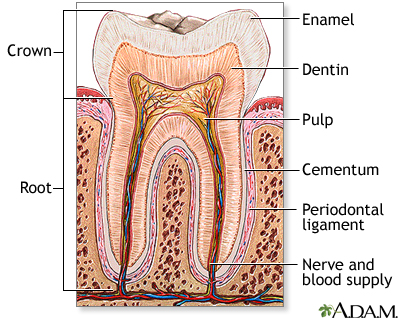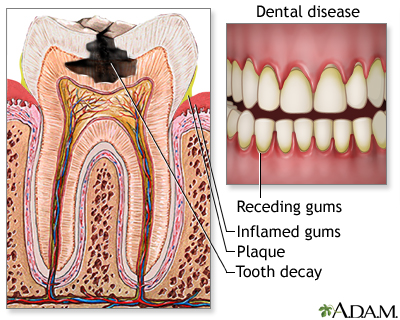Dental cavities
Caries; Tooth decay; Cavities - tooth
Dental cavities are holes (or structural damage) in the teeth.
Images



Causes
Tooth decay is a very common disorder. It most often occurs in children and young adults, but it can affect anyone. Tooth decay is a common cause of tooth loss in younger people.
Bacteria are normally found in your mouth. These bacteria change foods, especially sugar and starch, into acids. Bacteria, acid, food pieces, and saliva combine in the mouth to form a sticky substance called plaque. Plaque sticks to the teeth. It is most common on the back molars, just above the gum line on all teeth, and at the edges of fillings.
Plaque that is not removed from the teeth turns into a substance called tartar, or calculus. Plaque and tartar irritate the gums, resulting in gingivitis and periodontitis.
Plaque begins to build up on teeth within 20 minutes after eating. If it is not removed, it will harden and turn into tartar (calculus).
The acids in plaque damage the enamel covering your teeth. It also creates holes in the tooth called cavities. Cavities usually do not hurt, unless they grow very large and affect nerves or cause a tooth fracture. An untreated cavity can lead to an infection in the tooth called a tooth abscess. Untreated tooth decay also destroys the inside of the tooth (pulp). This requires more extensive treatment, or possibly removal of the tooth.
Carbohydrates (sugars and starches) increase the risk of tooth decay. Sticky foods are more harmful than non-sticky foods because they remain on the teeth. Frequent snacking increases the time that acids are in contact with the surface of the tooth.
Symptoms
There may be no symptoms. If symptoms occur, they may include:
- Tooth pain or achy feeling, particularly after sweet or hot or cold foods and drinks
- Visible pits or holes in the teeth
Exams and Tests
Most cavities are discovered in the early stages during routine dental checkups.
A dental exam may show that the surface of the tooth is soft.
Dental x-rays may show some cavities before they can be seen just by just looking at the teeth.
Treatment
Treatment of cavities can help prevent further tooth damage.
Treatment may involve:
- Fillings
- Crowns
- Root canals
Dentists fill teeth by removing the decayed tooth material with a drill and replacing it with a material such as composite resin, glass ionomer, or amalgam. Composite resin is the preferred material today, as it more closely matches the natural tooth appearance, and is also strong enough to use anywhere in the mouth, including the back teeth, where the majority of chewing takes place.
Crowns or "caps" are used if tooth decay is extensive and there is limited tooth structure, which may cause weakened teeth. Large fillings and weak teeth increase the risk of tooth fracture. The decayed or weakened area is removed and repaired. A crown is fitted over the remainder of the tooth. Crowns are often made of gold, porcelain, or porcelain fused to metal.
A root canal is recommended if the pulp is exposed to bacteria, or if the nerve in a tooth dies from decay or injury. The center of the tooth, including the nerve and blood vessel tissue (pulp), is removed along with decayed portions of the tooth. The roots are filled with a sealing material called gutta percha. The tooth is filled, and a crown is needed in most cases to seal and protect the tooth afterward.
Outlook (Prognosis)
Treatment often saves the tooth. Treatment is less painful and less expensive if it is done early.
You may need numbing medicine and prescription pain medicines to relieve pain during or after dental work.
Nitrous oxide with local anesthetic or other medicines may be an option if you are afraid of dental treatments.
Possible Complications
Dental cavities can lead to:
- Discomfort or pain
- Fractured tooth
- Inability to bite down on tooth
- Tooth abscess
- Tooth sensitivity
- Infection of the bone
- Bone loss
- Tooth loss
When to Contact a Medical Professional
Contact your dentist if you have any tooth pain, discomfort or see dark spots on your teeth.
See your dentist for a routine cleaning and exam if you have not had one in the last 6 months.
Prevention
Oral hygiene is necessary to prevent cavities. This consists of regular professional cleaning (every 6 months), brushing at least twice a day, and flossing at least daily. X-rays may be taken yearly to detect possible cavity development in high-risk areas of the mouth.
It is best to eat chewy, sticky foods (such as dried fruit or candy) as part of a meal rather than alone as a snack. If possible, brush your teeth or rinse your mouth with water after eating these foods. Limit snacking, since it creates a constant supply of sugars in your mouth. Avoid constant sipping of sugary drinks or frequent sucking on candy and mints.
Dental sealants can prevent some cavities. Sealants are thin plastic-like coatings applied to the chewing surfaces of the posterior teeth (premolars and molars). This coating prevents the buildup of plaque in the deep grooves on these surfaces. Sealants are often applied on the teeth of children, shortly after their molars come in. Older people may also benefit from tooth sealants.
Fluoride is often recommended to protect against tooth decay. People who get fluoride in their drinking water or by taking fluoride supplements have less tooth decay.
Topical fluoride is also recommended to protect the surface of the teeth. This may include a fluoride toothpaste or mouthwash. Many dentists include application of topical fluoride solutions (applied to the teeth) as part of routine visits.
Related Information
Common coldGingivitis
Tooth abscess
Carbohydrates
References
Berg J, Gerweck C, Hujoel PP, et al; American Dental Association Council on Scientific Affairs Expert Panel on Fluoride Intake From Infant Formula and Fluorosis. Evidence-based clinical recommendations regarding fluoride intake from reconstituted infant formula and enamel fluorosis: a report of the American Dental Association Council on Scientific Affairs. J Am Dent Assoc. 2011;142(1):79-87. PMID: 21243832 pubmed.ncbi.nlm.nih.gov/21243832/.
Chin JR, Kowolik JE, Martinez-Miar A, Ureña-Cirett JL. Dental caries in the child and adolescent. In: Dean JA, ed. McDonald and Avery's Dentistry for the Child and Adolescent. 11th ed. Philadelphia, PA: Elsevier; 2022:chap 10.
Chow AW. Infections of the oral cavity, neck, and head. In: Bennett JE, Dolin R, Blaser MJ, eds. Mandell, Douglas and Bennett's Principles and Practice of Infectious Diseases. 9th ed. Philadelphia, PA: Elsevier; 2020:chap 64.
Dhar VK. Dental caries. In: Kliegman RM, St. Geme JW, Blum NJ, et al,eds. Nelson Textbook of Pediatrics. 22nd ed. Philadelphia, PA: Elsevier; 2025:chap 358.
Rutter P. Gastroenterology. In: Rutter P, ed. Community Pharmacy. 5th ed. Philadelphia, PA: Elsevier; 2021:chap 7.
BACK TO TOPReview Date: 3/31/2024
Reviewed By: Michael Kapner, DDS, General Dentistry, Norwalk Medical Center, Norwalk CT. Review provided by VeriMed Healthcare Network. Also reviewed by David C. Dugdale, MD, Medical Director, Brenda Conaway, Editorial Director, and the A.D.A.M. Editorial team.

Health Content Provider
06/01/2025
|
A.D.A.M., Inc. is accredited by URAC, for Health Content Provider (www.urac.org). URAC's accreditation program is an independent audit to verify that A.D.A.M. follows rigorous standards of quality and accountability. A.D.A.M. is among the first to achieve this important distinction for online health information and services. Learn more about A.D.A.M.'s editorial policy, editorial process and privacy policy. A.D.A.M. is also a founding member of Hi-Ethics. This site complied with the HONcode standard for trustworthy health information from 1995 to 2022, after which HON (Health On the Net, a not-for-profit organization that promoted transparent and reliable health information online) was discontinued. |
The information provided herein should not be used during any medical emergency or for the diagnosis or treatment of any medical condition. A licensed medical professional should be consulted for diagnosis and treatment of any and all medical conditions. Links to other sites are provided for information only -- they do not constitute endorsements of those other sites. © 1997- 2025 A.D.A.M., a business unit of Ebix, Inc. Any duplication or distribution of the information contained herein is strictly prohibited.
